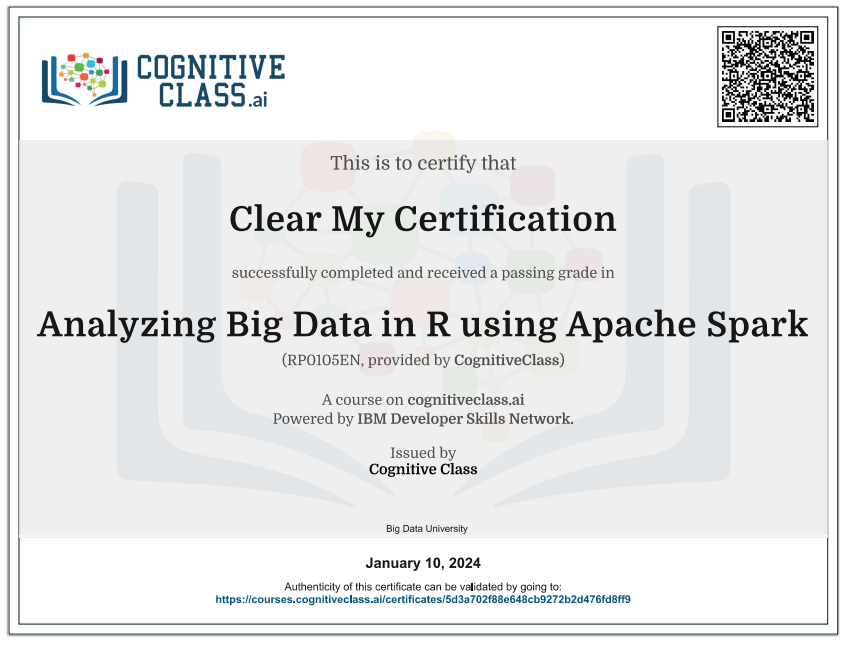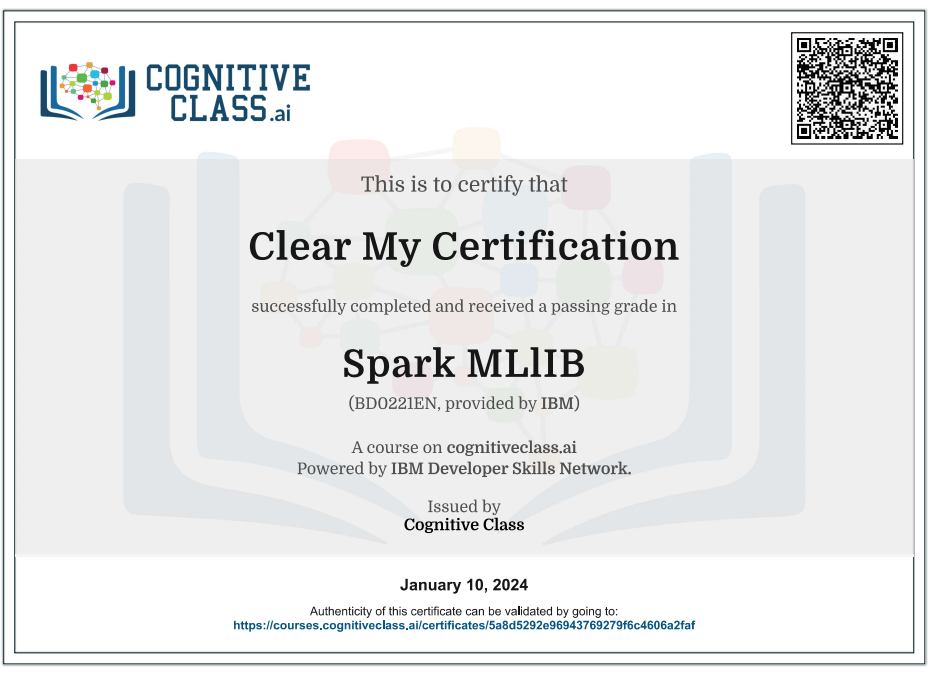Enroll Here: Hadoop 101 Cognitive Class Exam Quiz Answers
Hadoop 101 Cognitive Class Certification Answers

Module 1 – Introduction to Hadoop Quiz Answers – Cognitive Class
Question 1: Hadoop is designed for Online Transactional Processing. True or False?
- True
- False
Question 2: When is Hadoop useful for an application?
- When all of the application data is unstructured
- When work can be parallelized
- When the application requires low latency data access
- When random data access is required
Question 3: With the help of InfoSphere Streams, Hadoop can be used with data-at-rest as well as data-in-motion. True or false?
- True
- False
Module 2 – Hadoop Architecture & HDFS Quiz Answers – Cognitive Class
Question 1: Network bandwidth between any two nodes in the same rack is greater than bandwidth between two nodes on different racks. True or False?
- True
- False
Question 2: Hadoop works best on a large data set. True or False?
- True
- False
Question 3: HDFS is a fully POSIX compliant file system. True or False?
- True
- False
Module 3 – Hadoop Administration Quiz Answers – Cognitive Class
Question 1: You can add or remove nodes from the open source Apache Ambari console. True or False?
- True
- False
Question 2: It is recommended that you start all of the services in Ambari in order to speed up communications. True or False?
- True
- False
Question 3: To remove a node using Ambari, you must first remove all of the services using that node. True or False?
- True
- False
Module 4 – Hadoop Components Quiz Answers – Cognitive Class
Question 1: The output of the shuffle operation goes into the mapper before going into the reducer. True or False?
- True
- False
Question 2: What is true about Pig and Hive in relation to the Hadoop ecosystem?
- HiveQL requires that you create the data flow
- PigLatin requires that the data have a schema
- Fewer lines of code are required compared to a Java program
- All of the above
Question 3: Which of the following tools is designed to move data to and from a relational database?
- Pig
- Flume
- Oozie
- Sqoop
Hadoop 101 Final Exam Answers – Cognitive Class
Question 1: HDFS is designed for:
- Large files, streaming data access, and commodity hardware
- Large files, low latency data access, and commodity hardware
- Large files, streaming data access, and high-end hardware
- Small files, streaming data access, and commodity hardware
- None of the options is correct
Question 2: The Hadoop distributed file system (HDFS) is the only distributed file system supported by Hadoop. True or false?
- True
- False
Question 3: The input to a mapper takes the form < k1, v1 > . What form does the mapper’s output take?
- < list(k2), v2 >
- list( < k2, v2 > )
- < k2, list(v2) >
- < k1, v1 >
- None of the options is correct
Question 4: What is Flume?
- A service for moving large amounts of data around a cluster soon after the data is produced.
- A distributed file system.
- A programming language that translates high-level queries into map tasks and reduce tasks.
- A platform for executing MapReduce jobs.
- None of the options is correct
Question 5: What is the purpose of the shuffle operation in Hadoop MapReduce?
- To pre-sort the data before it enters each mapper node.
- To distribute input splits among mapper nodes.
- To transfer each mapper’s output to the appropriate reducer node based on a partitioning function.
- To randomly distribute mapper output among reducer nodes.
- None of the options is correct
Question 6: Which of the following is a duty of the DataNodes in HDFS?
- Control the execution of an individual map task or a reduce task.
- Maintain the file system tree and metadata for all files and directories.
- Manage the file system namespace.
- Store and retrieve blocks when told to by clients or the NameNode.
- None of the options is correct
Question 7: Which of the following is a duty of the NameNode in HDFS?
- Control the MapReduce job from end-to-end
- Maintain the file system tree and metadata for all files and directories
- Store the block data
- Transfer block data from the data nodes to the clients
- None of the options is correct
Question 8: Which component determines the specific nodes that a MapReduce task will run on?
- The NameNode
- The JobTracker
- The TaskTrackers
- The JobClient
- None of the options is correct
Question 9: Which of the following characteristics is common to Pig, Hive, and Jaql?
- All translate high-level languages to MapReduce jobs
- All operate on JSON data structures
- All are data flow languages
- All support random reads/writes
- None of the options is correct
Question 10: Which of the following is NOT an open source project related to Hadoop?
- Pig
- UIMA
- Jackal
- Avro
- Lucene
Question 11: During the replication process, a block of data is written to all specified DataNodes in parallel. True or false?
- True
- False
Question 12: With IBM BigInsights, Hadoop components can be started and stopped from a command line and from the Ambari Console. True or false?
- True
- False
Question 13: When loading data into HDFS, data is held at the NameNode until the block is filled and then the data is sent to a DataNode. True or false?
- True
- False
Question 14: Which of the following is true about the Hadoop federation?
- Uses JournalNodes to decide the active NameNode
- Allows non-Hadoop programs to access data in HDFS
- Allows multiple NameNodes with their own namespaces to share a pool of DataNodes
- Implements a resource manager external to all Hadoop frameworks
Question 15: Which of the following is true about Hadoop high availability?
- Uses JournalNodes to decide the active NameNode
- Allows non-Hadoop programs to access data in HDFS
- Allows multiple NameNodes with their own namespaces to share a pool of DataNodes
- Implements a resource manager external to all Hadoop frameworks
Question 16: Which of the following is true about YARN?
- Uses JournalNodes to decide the active NameNode
- Allows non-Hadoop programs to access data in HDFS
- Allows multiple NameNodes with their own namespaces to share a pool of DataNodes
- Implements a resource manager external to all Hadoop frameworks
Question 17: Which of the following sentences is true?
- Hadoop is good for OLTP, DSS, and big data
- Hadoop includes open-source components and closed source components
- Hadoop is a new technology designed to replace relational databases
- All of the options are correct
- None of the options is correct
Question 18: In which of these scenarios should Hadoop be used?
- Processing billions of email messages to perform text analytics
- Obtaining stock price trends on a per-minute basis
- Processing weather sensor information to predict a hurricane path
- Analyzing vital signs of a baby in real time
- None of the options is correct
Introduction to Hadoop 101
Hadoop is an open-source framework for distributed storage and processing of large sets of data using a cluster of commodity hardware. It is designed to scale from single servers to thousands of machines, offering a reliable, scalable, and fault-tolerant distributed storage and processing system.
Key components of the Hadoop ecosystem include:
- Hadoop Distributed File System (HDFS): HDFS is a distributed file system designed to store vast amounts of data across multiple machines. It divides large files into smaller blocks and distributes them across the cluster. The data is replicated for fault tolerance.
- MapReduce: MapReduce is a programming model and processing engine for distributed data processing. It consists of two main phases – the Map phase, where data is processed and transformed into key
 Clear My Certification All Certification Exam Answers
Clear My Certification All Certification Exam Answers



